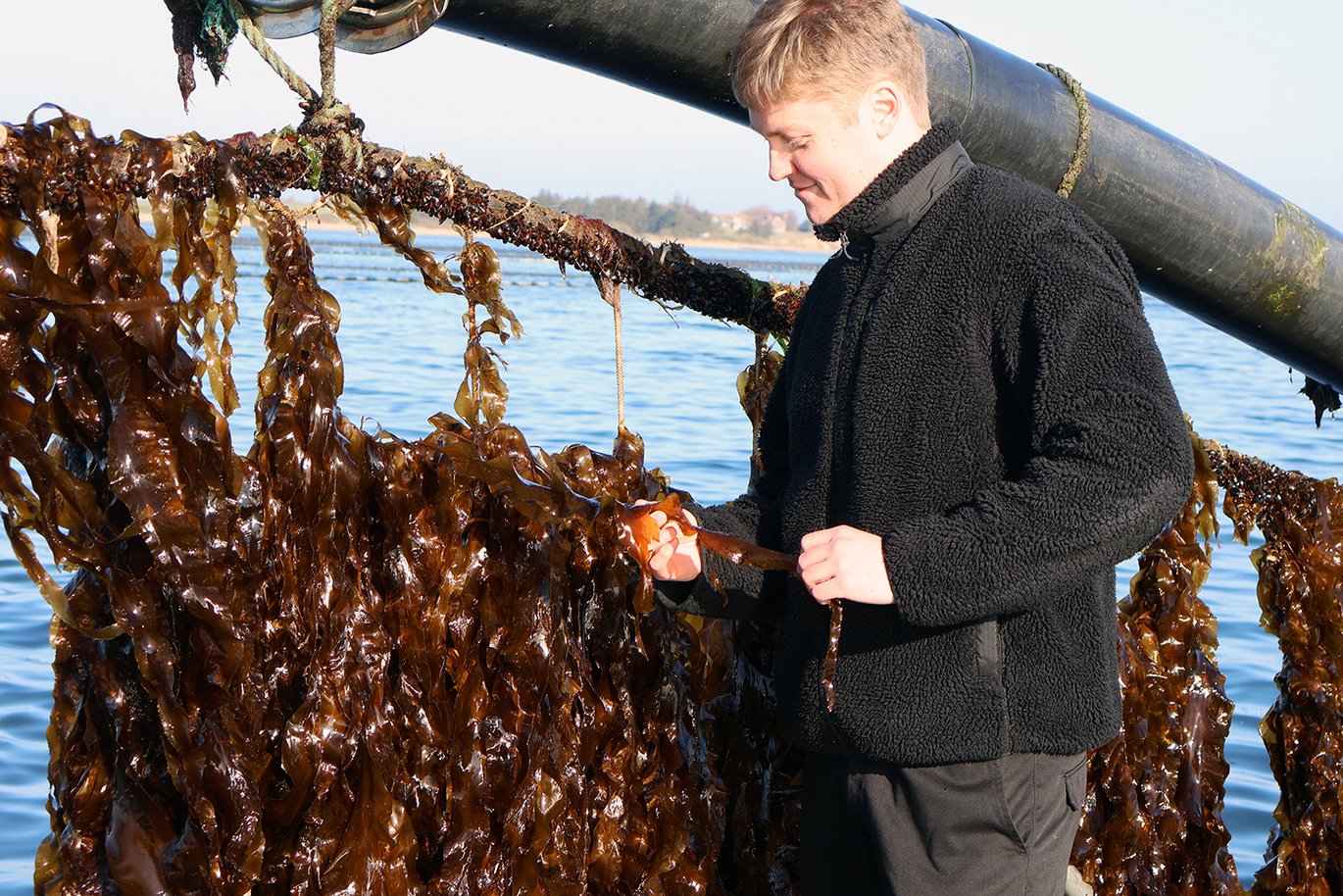Record yield with horizontal seaweed farming in Denmark
Sugar kelp grown on horizontal mesh nets in the Limfjord demonstrates high productivity and potential environmental benefits, according to new Danish research.

Danish researchers, including teams from Aarhus University and the Technical University of Denmark, have harvested up to 13.2 kg of sugar kelp per square metre of net in the Limfjord. This is one of the highest yields ever recorded in a single season of Danish seaweed farming.
The method behind the success involves suspending wide-meshed nets horizontally in the water - an approach that has proven more effective than traditional vertical line systems, allowing more light to reach the seaweed.
"We’ve observed very high growth rates. Our analysis shows that horizontally suspended nets yield the most, simply because they make better use of the light in the water column compared to vertical systems, which shade themselves," explains project leader Teis Boderskov from the Department of Ecoscience at Aarhus University.
In addition to better light utilization, horizontal nets are less likely to tangle, making them a promising model for future seaweed farming in Denmark.
"Results from the nets are excellent, but new designs from Norway show that seaweed lines can be placed just half a metre apart. Our data suggest that this denser line farming can be just as efficient as horizontal net systems," says Boderskov. "Although we optimized the seeding process for nets during the project, they still take up a lot of space in the hatchery and are difficult to handle during deployment and harvest."
Seaweed farming as a marine environmental tool
Besides high yields, the project also highlights the potential of seaweed farming to improve marine ecosystems. The sugar kelp absorbs nitrogen and phosphorus during growth, and when harvested, it removes these nutrients from the water - nutrients that otherwise contribute to algae blooms and oxygen depletion.
"We're removing something instead of adding it. It’s a new way of thinking about marine aquaculture. Seaweed farming can help improve ecosystems in nutrient-rich coastal areas like the Limfjord," says Boderskov.
The nets also act as artificial reefs, offering shelter and food to small fish and other marine organisms. When not harvested, seaweed farms can develop into biodiversity hotspots, suggesting that with the right management, farming could benefit marine life.
From harvesting to applications
To scale seaweed production, the project also tested mechanical harvesting methods. Existing mussel harvesting machines couldn’t manage the seaweed, so specialized scraping tools were developed.
"We assumed that scrapers with knives or teeth could pull the seaweed off, but that didn’t work. However, we found that seaweed could be pumped out of the machine just like mussels - which was uncertain before the project," says Boderskov.
The project explored multiple harvesting solutions, including a new concept with clippers designed by a Dutch company and an automated overwater harvester developed by engineering student Markus Platz from Aarhus University.
After harvest, the seaweed has been tested for use in food and animal feed. The company Wavy Wonders developed edible kelp-based snacks, while fermented seaweed was used in pig feed trials.
"Seaweed contains unique compounds not found in land plants. This opens doors for applications in animal feed, fertilizers, functional foods - and potentially even pet food," says Boderskov. "It’s a resource with many possibilities, but we need to find the applications where it makes the most sense functionally, economically, and sustainably."
He is supported by Jens Legarth, CEO of Fermentationexperts, who is also part of the project:
"Fermenting seaweed with rapeseed creates a highly anti-inflammatory and antimicrobial product that supports gut health in livestock and improves livestock productivity. Seaweed could reduce the need for several antibiotic products and even help combat resistant bacteria," he says.
Other studies support these findings, showing that seaweed’s high levels of special sugars and bioactive compounds can positively influence gut flora in both animals and humans. There's also strong interest in developing bio-based ingredients for the food industry.
Researchers are now awaiting results from a life cycle analysis comparing the environmental footprint of net-based and line-based seaweed farming.
"This isn’t a celebration story - yet. Seaweed is still an expensive raw material. But we’ve shown that it’s technically and biologically feasible. The next step is to mature the technology and identify the best applications," concludes Teis Boderskov.
Facts
External funding: Danish Ministry of Food, Agriculture and Fisheries (GUDP)
Partners: Aarhus University, DTU Aqua, Blå Biomasse A/S, Wavy Wonders, KOST Studio, Fermentationexperts, University of Copenhagen
Contact
Teis Boderskov
Department of Ecoscience
Mail: tebo@ecos.au.dk
Tel.: +4560919639
